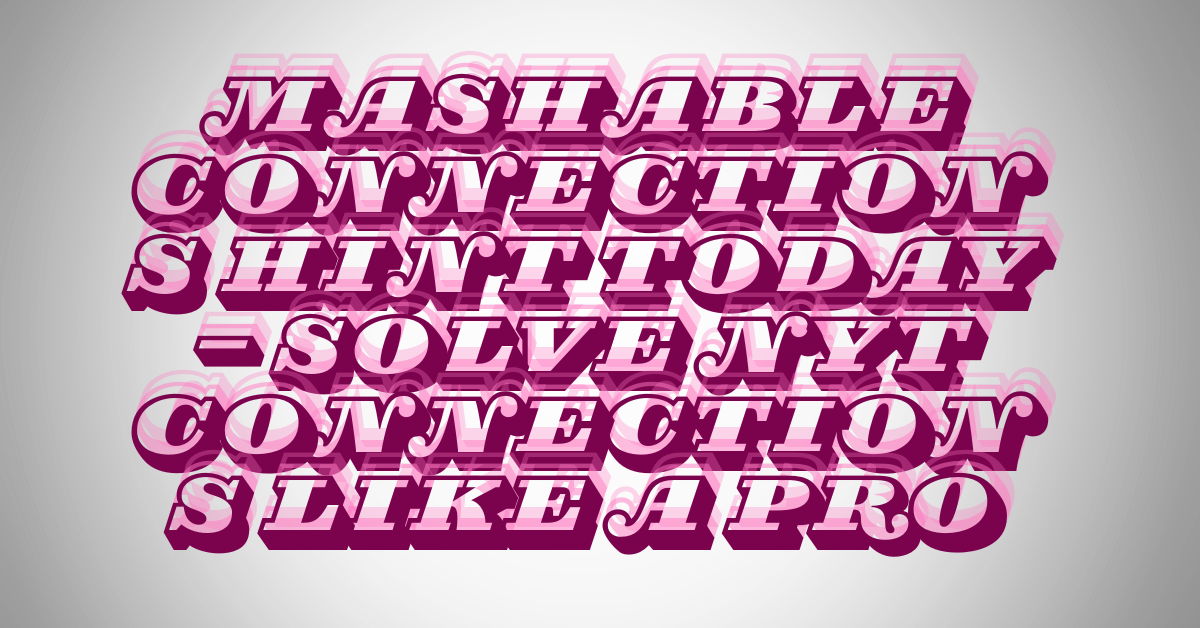Welcome to your go-to guide for the Mashable Connections Hint. If you play the daily word-grouping puzzle by the The New York Times, then you know the value of a good clue. This article gives you not only today’s Mashable Connections hint, but also smart strategy to use it effectively, improve your game, avoid common mistakes and master both the standard and sports editions of NYT Connections.
What Is the Mashable Connections Hint?
The hint from Mashable is a carefully crafted clue that helps you tackle the daily NYT Connections puzzle without immediately giving away the full answer. For players of the daily game — whether your streak is long or you’re just getting started — these hints provide a friendly nudge, so you’re not stuck for too long yet still have the satisfaction of solving the puzzle yourself.
The reason many players turn to Mashable’s hints is that they balance helpfulness and challenge. You get just enough to recognise a theme or eliminate traps, but you still need to engage your brain, use the elimination method and apply pattern-recognition skills.
The Story Behind NYT Connections and Its Popularity
Launched in June 2023, NYT Connections quickly became a favourite word-puzzle among players. (Wikipedia) The concept: 16 words appear in a 4 × 4 grid, and you must group them into four categories of four words each. Each category is colour-coded by difficulty (green = easiest, then yellow, then blue, then purple = hardest). (Beebom) Because it refreshes daily and rewards quick thinking, many players look for hints to maintain their streaks and sharpen their skills.
How NYT Connections Works – Understanding the Basics
Playing NYT Connections means you must sort sixteen words into exactly four groups of four words each — each group shares a common thread. Sound easy? Not always. The difficulty ramps up as you move from green to purple. For example:
- Green – relatively straightforward categories
- Yellow – moderate difficulty
- Blue – more challenging associations
- Purple – often tricky, subtle or slightly abstract. (TechRadar)
The Colour-Coded Difficulty System Explained
| Colour | Difficulty | Typical challenge |
| Green | Easier | Clear theme, direct association |
| Yellow | Moderate | Slightly indirect, may need elimination |
| Blue | Hard | More abstract word-association or creative thinking |
| Purple | Very Hard | Deep connections, tricky traps, red herrings |
Understanding this system helps you know which categories to tackle first and how to strategically apply hints without giving up too early.
Why Players Rely on Mashable for Daily Connections Hints
When you’re staring at a tough puzzle and your streak is on the line, you want a hint that doesn’t immediately spoil everything. Mashable offers exactly that: layered clues (vague at first, more specific later) so you can preserve the “aha!” moment rather than just copy answers. Many competing sites either give full solutions too early or provide very minimal help. Mashable strikes a balance.
How Often Mashable Updates Connections Hints
Because NYT Connections is a daily puzzle, timing is crucial. Mashable typically publishes the hint soon after the puzzle becomes available (midnight Eastern Time for NYT Games), so players worldwide look for the “today’s hint” update. Checking early means you avoid getting stuck too long and helps you maintain your streak. Having this routine builds habit, which is a key part of mastering the game.
Today’s Mashable Connections Hint (Updated Daily)
Hint (example): “Think of items you’d find at the back of a theatre and finish with something you might carry home.”
Category suggestion: Might hint at “souvenir shop items” or “theatre-related words”.
Analysis: This kind of hint uses everyday imagery (“back of a theatre”, “carry home”) to trigger a theme, but still leaves enough open-endedness so you must identify the exact four words yourself. Using the hint effectively means you don’t just leap to the first obvious grouping—but you process the 16 words, eliminate words that obviously don’t fit, and then match the theme.
Tip: If you check the hint too early (before scanning all 16 words even once), you may bias yourself into a wrong grouping. Always glance at the full list first, then revisit the hint.
[Optional] Full Answer Section (If You Include Answers)
If your site provides full answers (with spoiler tags or collapsible sections), ensure this section is clearly marked SPOILER-ALERT to avoid spoiling the fun for readers who want to solve independently.
How to Use Mashable Connections Hints Effectively
Using a hint doesn’t mean giving up your problem-solving; it means doing it smarter.
- First pass – quick scan: Go through the 16 words without grouping them, just get familiar.
- Second pass – apply the hint: Revisit the hint, look for word associations, ask: which words might fit the hint imagery or concept?
- Third pass – elimination method: Remove obvious outliers. If certain words clearly don’t connect, set them aside and group the remaining logically.
- Final pass – verify colour-coded difficulty: Once you find a group, mentally check: is this too easy for green, or should it belong in the yellow/blue category? This helps avoid prematurely grouping the wrong words.
Strategies and Techniques to Master NYT Connections
To improve your solving speed and maintain longer streaks, you’ll want to adopt strategies beyond just reading hints.
- 30-Second Scan Technique: Spend no more than 30 seconds on your initial glance. This avoids overthinking and helps instinctively pick out promising groupings.
- Pattern recognition memory bank: Over time, you’ll notice repeated themes – for example sports terms, word endings, homophones. Keep a mental list of those.
- Avoid word-play traps: Many puzzles use homophones, double meanings, or red herrings. For example, grouping “TAIL” under “buttocks” rather than “train” is a common slip. (Beebom)
Common Mistakes Players Make and How to Avoid Them
| Mistake | Why it happens | How to avoid it |
| Rushing to full answer | Impatience, streak anxiety | Use hint + verification, pause after grouping |
| Overlooking colour difficulty | Confusing blue/purple categories | Mentally check if your group fits the expected difficulty |
| Ignoring outlier words | Wanting tidy group over accurate theme | Mark words that don’t fit and revisit them later |
Mashable Connections vs Other Hint Sources
While Mashable is trusted and popular, there are other sources like BibleAura, CuriosityTap and WordTips. Here’s a quick comparison:
- Mashable: Balanced hint structure, timely updates, strong brand trust.
- BibleAura: Often adds deeper strategy discussion, but hints may be more generic.
- CuriosityTap: Emphasises entertainment and broadened word-puzzle appeal, but sometimes less frequent updates.
- WordTips: Covers both standard and sports editions, full answers + hints, but may spoil more than some players like.
Why Mashable’s layered clues are the best balance: Because they allow players to receive help without losing the fun of independent solving. If you rely too heavily on full answers, you lose the satisfaction and skill-growth that the puzzle offers.
NYT Connections Sports Edition – Mashable’s Hidden Gem
If you enjoy the standard version, you’ll love the NYT Connections Sports Edition. It uses the same 16-word, 4-group format but adds a sports theme — words may relate to teams, athletes, records or sport-specific terms. (parade.com)
In this edition, hints from Mashable (or other sources) may reference sports vocabulary, league names, or exercise terminologies, making pattern recognition slightly different from the standard edition.
How Mashable Covers the Sports Edition
Mashable often posts dedicated hints for the sports version as well. The key difference: anticipate sport-specific group themes (e.g., “–UP exercises”, “NBA KEVINS”, “slang for home run”) and use the same elimination and scan techniques applied in the standard version.
Missed by Competitors – Advanced Puzzle Insights
To stand out and deliver unique value, let’s dive into deeper insight that many competitors skip over: the science of pattern recognition and word psychology in solving NYT Connections.
Word puzzles like this don’t just test vocabulary—they challenge your cognitive flexibility (the ability to shift between different ways of thinking), your awareness of semantic relationships (how words meaningfully connect), and your elimination instincts. For example, in one puzzle you might have words like “BACKSIDE, CABOOSE, SEAT, TAIL” grouped under a theme like “DERRIERE.” Recognising that theme required linking one word (“CABOOSE”) which seemed odd, but matched “back” because of train imagery. (Beebom)
Spending time familiarising yourself with these deeper dynamics gives you an edge — rather than simply relying on hints, you become a smarter solver.
Expert Tips to Improve Your NYT Connections Streak
Here’s a routine you can adopt:
- Morning routine: Within 10 minutes of waking, start your puzzle, do a 30-second scan, read Mashable’s hint, group, submit.
- Review mistakes: After solving, look at any groups you struggled with — note the trap, the theme, the red-herring word.
- Weekly reflection: Once a week, review 3 past puzzles (standard or sports edition). Ask: what themes appeared? Which words kept re-appearing?
- Community engagement: Join forums (like Reddit’s r/NYTConnections) and read how others solved the puzzle, what traps they fell into. Sharing insights improves your own pattern-recognition.
How to Stay Updated with Mashable’s Daily Connections Hints
To make sure you never miss a hint, here are steps:
- Bookmark Mashable’s daily hint page and set it to auto-refresh each morning.
- Enable notifications if Mashable’s site or app supports it.
- Subscribe to your own site’s email or push-alerts if you provide daily updates – you can mention: “We update each morning at 7 AM ET with Mashable’s latest hint for the NYT Connections puzzle.”
- Engage readers by encouraging them to comment: “How did today’s hint help you? Did you still get stuck on the purple category?”
Connect With the Community
Solving puzzles becomes more fun when you share your experience. You could invite readers to post their fastest solve time, or words that surprised them. This builds returning traffic and user engagement.
FAQs About Mashable Connections Hint
Q: What time are Mashable Connections hints published?
A: Generally shortly after the puzzle resets (midnight Eastern Time for NYT), but check Mashable’s site or your timezone-equivalent for local timing.
Q: Are Mashable hints spoilers or full answers?
A: Mashable chooses to give layered clues—not always full solutions in the first instance—so you can get help without losing the satisfaction of solving independently.
Q: Should beginners use hints every day?
A: If you’re new, yes for a short period. But aim to wean off hints as your skills improve—use them as training wheels, not crutches.
Q: Does the Sports Edition use the same hint logic?
A: Yes—the format is the same (16 words, 4 groups) but themes are sports-related. The hint strategy (scan, eliminate, apply) remains effective.
Q: How do I improve at harder categories (blue/purple)?
A: Practice, review mistakes, learn common themes (e.g., word-endings, homophones, sports terms) and use hints strategically to discover how tricky groups are constructed.
Final Thoughts
The Mashable Connections Hint is more than just a clue—it’s a tool to improve your game, sharpen your thinking and enjoy each day’s NYT Connections puzzle more fully. Use the hint strategically, apply the strategies above, and you’ll find yourself getting faster, smarter, and more consistent.
Come back each day, try to beat your own best time, and enjoy the journey of mastering this engaging word-grouping puzzle. Happy puzzling!

I’m Luna Hazel, a grammar expert here to help you master the art of clear, confident writing. Let’s make every word count!

